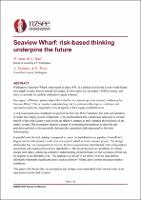Seaview Wharf: risk-based thinking underpins the future

Download
Date
2021-04-14Authors
Juno, Wayne
Hall, Liam
Delaney, Anthony
Metadata
Show full item recordAbstract
Wellington’s Seaview Wharf is a critical asset in the Lower North Island fuel supply system, including after significant seismic events. Recent annual fuel supply for the region has exceeded 1 Million tonnes, and there is currently no credible alternative.
One aspect of Holmes’ partnership with CentrePort is a renewal process currently underway for Seaview Wharf. This is based on understanding risk to improve systematic resilience and operational outcomes, targeted to critical aspects for fuel supply and distribution.
A risk assessment was completed not just for the Seaview Wharf structure, but with consideration of wider fuel supply system components. This demonstrated that a traditional approach to seismic retrofit of the wharf alone would not be an effective strategy to truly enhance the resilience of the supply system. The study adopted a range of communication methods to prioritise and describe activities to incrementally decrease the operational risks presented by the built infrastructure.
In parallel with industry’s proposal to renew the fuel distribution pipeline, CentrePort’s largest current work item for its infrastructure is a targeted wharf structure renewal project. The design philosophy has risk management at its core. It draws on numerous international codes and guidance documents, plus requirements of key stakeholders. The design focuses on operability at various design limit states; enhancing collective understanding of performance so that resilience efforts can be targeted in an affordable way. This approach is critical to the ability over the long term to affordably insure significant assets, such as Seaview Wharf, given current insurance market conditions.
